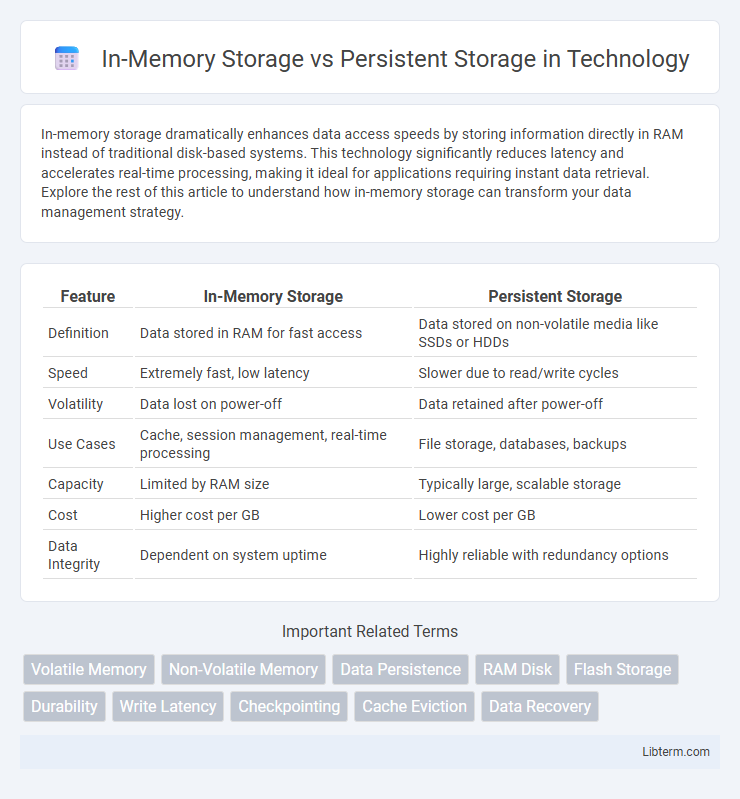In-memory storage dramatically enhances data access speeds by storing information directly in RAM instead of traditional disk-based systems. This technology significantly reduces latency and accelerates real-time processing, making it ideal for applications requiring instant data retrieval. Explore the rest of this article to understand how in-memory storage can transform your data management strategy.
Table of Comparison
| Feature | In-Memory Storage | Persistent Storage |
|---|---|---|
| Definition | Data stored in RAM for fast access | Data stored on non-volatile media like SSDs or HDDs |
| Speed | Extremely fast, low latency | Slower due to read/write cycles |
| Volatility | Data lost on power-off | Data retained after power-off |
| Use Cases | Cache, session management, real-time processing | File storage, databases, backups |
| Capacity | Limited by RAM size | Typically large, scalable storage |
| Cost | Higher cost per GB | Lower cost per GB |
| Data Integrity | Dependent on system uptime | Highly reliable with redundancy options |
Introduction to In-Memory and Persistent Storage
In-memory storage leverages RAM to store data temporarily, enabling rapid data access and low latency compared to disk-based systems. Persistent storage, such as SSDs or HDDs, permanently retains data even after power loss, ensuring durability and long-term availability. The trade-off between these storage types centers on speed versus data persistence, aligning with varying application requirements for performance and reliability.
Key Differences Between In-Memory and Persistent Storage
In-memory storage provides ultra-fast data access by storing information directly in a system's RAM, ideal for real-time applications but limited by volatility and cost. Persistent storage, such as SSDs or HDDs, retains data permanently even during power outages, ensuring durability at the expense of slower read/write speeds. Key differences include access speed, data retention, cost per gigabyte, and use cases, with in-memory excelling in speed-sensitive environments and persistent storage prioritizing data reliability.
Performance Comparison: Speed and Latency
In-memory storage offers significantly faster read and write speeds compared to persistent storage due to data being accessed directly from RAM, resulting in latency measured in nanoseconds. Persistent storage, such as SSDs or HDDs, involves mechanical or electronic retrieval processes that typically introduce latency in the microsecond to millisecond range, impacting data-intensive applications. High-performance computing and real-time analytics heavily favor in-memory solutions to minimize latency and maximize throughput, while persistent storage is prioritized for durability and long-term data retention.
Data Durability and Reliability Considerations
In-memory storage offers faster data access and processing speeds compared to persistent storage but lacks durability as data is lost during power failures or system crashes. Persistent storage ensures data durability by saving information to non-volatile media such as SSDs or HDDs, providing reliable long-term data retention even after shutdowns. For mission-critical applications, combining in-memory storage with persistent storage solutions like write-ahead logs or snapshots enhances both speed and data reliability.
Scalability and Flexibility in Storage Solutions
In-memory storage offers superior scalability by enabling rapid data access and real-time processing, significantly enhancing system responsiveness during high-demand scenarios. Persistent storage provides greater flexibility with long-term data retention and durability, supporting diverse data types and complex workloads across distributed environments. Balancing in-memory and persistent storage solutions maximizes performance scalability while ensuring reliable, flexible data management tailored to evolving business needs.
Use Cases for In-Memory Storage
In-memory storage is ideal for applications requiring ultra-fast data access and low latency, such as real-time analytics, gaming leaderboards, and financial trading platforms. It excels in session management, caching, and personalized user experiences where data consistency can be eventual rather than immediate. Organizations leverage technologies like Redis and Memcached to optimize performance in scenarios demanding rapid data retrieval and high throughput.
Use Cases for Persistent Storage
Persistent storage is essential for use cases requiring data durability and long-term retention, such as databases, file systems, and backup solutions. It supports applications that demand recovery from failures, regulatory compliance, and archival of business-critical information. This storage type is crucial for environments needing consistent data access across sessions and devices, including cloud storage platforms and enterprise resource planning (ERP) systems.
Cost Implications: In-Memory vs Persistent Storage
In-memory storage demands higher costs due to the expense of RAM modules compared to persistent storage, which leverages more affordable hard drives or SSDs with larger capacities. The operational expenses for in-memory solutions increase with scaling, as maintaining data solely in volatile memory requires continuous power and specialized hardware. Persistent storage reduces cost per gigabyte, making it more economical for long-term, large-scale data retention despite slower access speeds.
Security and Data Integrity Challenges
In-memory storage offers rapid data access but faces vulnerabilities like data loss during power failures and increased risk of unauthorized access due to volatile memory. Persistent storage provides enhanced data integrity with durable, non-volatile media, but it requires robust encryption and access control mechanisms to prevent tampering and unauthorized retrieval. Balancing security measures such as encryption, authentication, and regular backups is crucial to mitigate risks inherent in both storage types.
Choosing the Right Storage Solution for Your Needs
In-memory storage offers ultra-fast data access ideal for real-time analytics and caching, while persistent storage ensures data durability and long-term retention essential for compliance and backup. Selecting the right storage solution depends on workload requirements, latency tolerance, and data volatility; use in-memory for transient, high-speed operations and persistent storage for critical, reliable data retention. Hybrid architectures combine both, optimizing performance and resilience by leveraging the speed of RAM and the safety of disk-based systems.
In-Memory Storage Infographic

 libterm.com
libterm.com